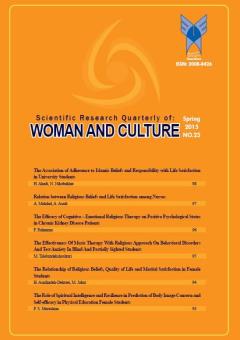The Effectiveness Of Music Therapy With Religious Approach On Behavioral Disorders And Test Anxiety In Blind And Partially Sighted Students
Subject Areas : PsychologyMarzeyeh Talebzadehshoshtari 1
1 - Islamic Azad University Ahvaz Branch, Department of Psychology, Ahvaz, Iran.
Keywords:
Abstract :
The purpose of present research was to examine the effectiveness of music therapy with religious approach on behavioral disorders and test anxiety in blind and partially sighted in elementary school students in Ahvaz. The sample consisted of 40 blind and partially sighted students) 20 boy and 20 girls) whom were randomly selected and divided into experiment and control groups. The research was experimental design of pre-test and post-test with a control group. the pre-test was administered for two groups then experimental group received 15 Quran song sessions each for a period of 30 minutes. For collecting data Rotter Behavioral Disorders Test and Ahwaz test Anxiety Inventory were used. Multivariate analysis of variance MANOVA was applied to analyze the obtained data. The results showed that at the end of the training course, in experimental group behavioral disorders and test anxiety were decreased in comparison to the control group (p<0.001). So the research concluded that music therapy with religious approach decreased the behavioral disorders and test anxiety in blind and partially sighted elementary school students and it was suggested the using of music therapy with religious approach along with the other common treatments as a complementary therapy to decrease the mentioned symptoms in blind and partially sighted students.
ابوالقاسمی، ع.، نریمانی، م.، و کیامرثی، آ. (1384). بررسی میزان شیوع و هم ابتلایی اختلالهای رفتاری در دانش آموزان دوره ابتدایی و ارتباط آن با پیشرفت تحصیلی. فصلنامه علم و فناوری، 4(2): 36-25.
احمدی، ا. (1385). بررسی تأثیر موسیقی درمانی به عنوان یک فرایند درمانی بر کاهش اضطراب دانشآموزان پیش دانشگاهی. مجموعه مقالات اولین کنگره سراسری هنر درمانی در ایران، تهران.
اعتمادی، ع. (1384). ایمان و معنویت در مشاوره و روان درمانی. فصلنامه تازه های روان درمانی، 10(35-36): 146-131.
انصاری جابری، ع.، نگاهبان بنابی، ط.، صیادی اناری، ا.، و آقا محمد حسنی، پ. (1385). آوای قرآن کریم و افسردگی. مجموعه مقالات اولین کنگره سراسری هنر درمانی در ایران، تهران.
جراره، ج و محمدی کرکانی، آ.(1392). اثربخشی آموزش شناختی رفتاری بر اضطراب امتحان دانش آموزان دخترمتوسطه. فناوری آموزش، 4(7): 313-307.
حیدری، م.، و شهبازی، س. (1392). بررسی تأثیر آوای قرآن و موسیقی بدون کلام بر اضطراب بیماران کاندید آندوسکوپی. فصلنامهدانشوتندرستی، 8(2): 70-67.
راه نجات، ا. (1382). بررسی تأثیر موسیقی بر کاهش اضطراب و افسردگی گروهی از جانبازان مبتلا به اختلال استرس پس از سانحه روانی در مرکز روانپزشکی صدر. مجموعه مقالات چهارمین کنگره سراسری کاربرد موسیقی در سلامت جسم و روان، تهران.
زاده محمدی، ع. (1388). کاربردهای موسیقی درمانی. تهران: انتشارات اسرار دانش.
سلطان پناه، ح. (1382). مبانی موسیقایی الحان و نغمات قرآن کریم. چاپ اول، قم: انتشارات اسوه.
شاه میوه اصفهانی، غ. (1388). پژوهشی در جلوههای موسیقایی هنر تلاوت. چاپ اول، قم: انتشارات اسوه.
عسگری، پ.، حیدری، ع.، نادری، ف.، مرعشیان، ف.، تقی پور، س.، و ضمیری، ا. (1388). راهنمای آزمون های روانشناختی1. انتشارات دانشگاه آزاد اسلامی واحد اهواز .
کمال پورتراب، م. (1393). تئوری موسیقی. چاپ پنجاه و سوم، تهران: نشرچشمه.
گشول، م.، کرمی، ب.، و خوشکلام، ا. (1393). اثربخشی موسیقی درمانی بر رفتارهای کلیشهای، رفتارهای آسیب به خود و رفتارهای پرخاشگرانه کودکان اتیستیک. فصلنامه روانشناسی افراد استثنایی، 4(15): 149-132.
معصومی، م.، گنجو، م.، و اکبری، ز. (1392). مقایسه تاثیرآوای قرآن و آوای موسیقی بر اضطراب امتحان دانشجویان، طب مکمل، 2(1): 480-471.
نادری، ف.، و طالب زاده شوشتری، م. (1385). تأثیر آوای ملکوتی قرآن کریم بر میزان امیدواری بیماران زن و مرد مبتلا به سرطان شهر اهواز. مجموعه مقالات اولین کنگره سراسری هنر درمانی در ایران، تهران.
نادری، ف.، و مکوندی، ب. (1382). تأثیر موسیقی بر یادگیری و عملکرد تحصیلی کودکان عقب مانده ذهنی. مجموعه مقالات چهارمین کنگره سراسری کاربرد موسیقی در سلامت جسم و روان، تهران.
Baxter, C. (2006). Music therapy helps, Retrieved Jon 2006 from. http:// proquest. Umi. Com.
Cooding, P. (1982).Music therapy for handicapped children: Visually impaired. Washington D.C: National Association for music therapy.
Fehring, R. J., Miller, J. F., & Shaw, C. (2010). Spiritual wellbeing, religiosity, hope, depression, and other mood states in elderly people coping with cancer. Oncology Nursing Forum, 24(1): 663-671.
Hodges, N. (2007). Test Anxiety in Exceptional students, Retrieved Jun 2007 from. http, // www. Nssa. Us/.
Huberty, T. J. (2010). Test and performance anxiety. Education Digest, 75(2): 34-38.
Kenyon, T. (2007). Effects of music therapy on surgical and cancer patients. Breast care, 2(2): 217-220.
Klein. R., & Pnina. S. (1981). Responses of hyperactive and normal children to variations in tempo of background music. Journal of psychiatry and related sciences, 18(2): 154 – 166.
Nocera, S. D. (1979). Reaching the Special Learner through Music. Silver Burdett Company.
Ruth. M., & Locsin. R. (2004). The effect of music listening on acute confusion and delirium in elders undergoing elective hip and knee surgery. Journal of Clinical Nursing, 13(6): 91-96.
Wong, H. L., Grad Dip, Lopez-Nahas, V., & Molassiotis, A. (2002). Effects of music therapy on anxiety in Ventilator- dependent patients. Heart & lung, 30(5): 376-87.
_||_

